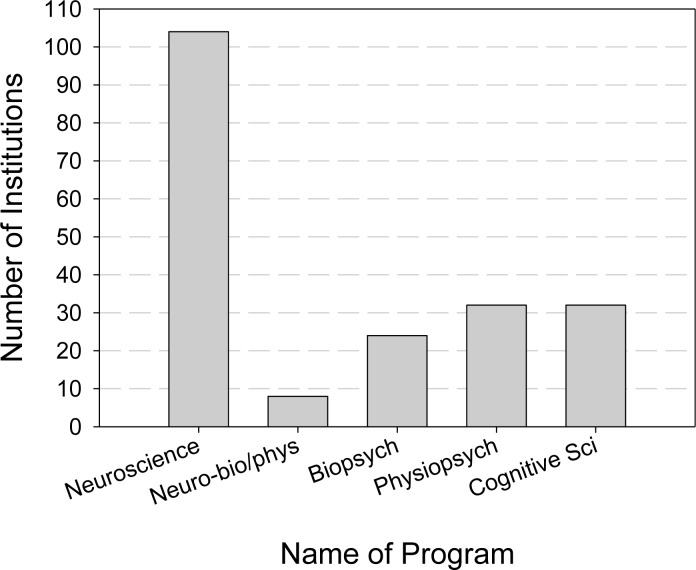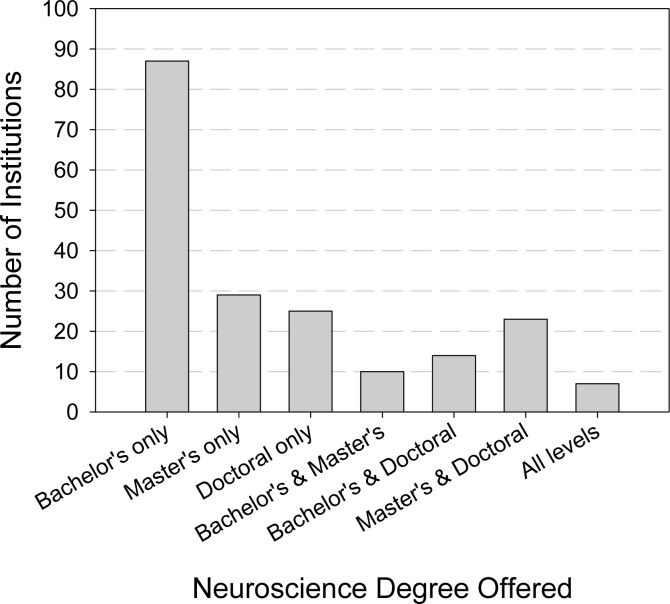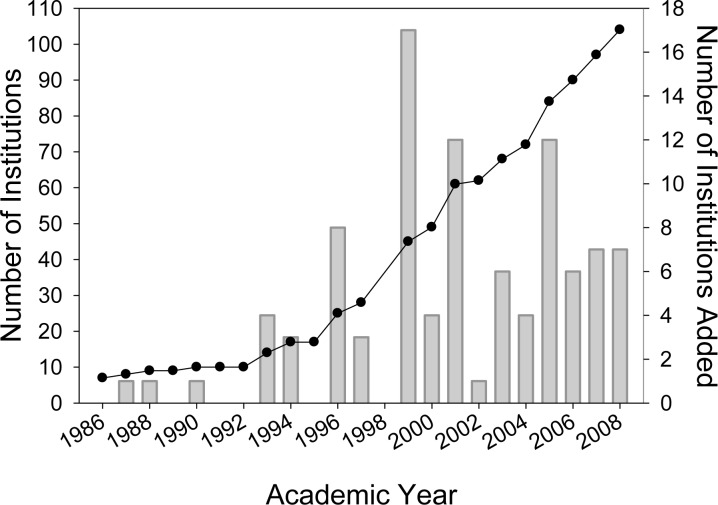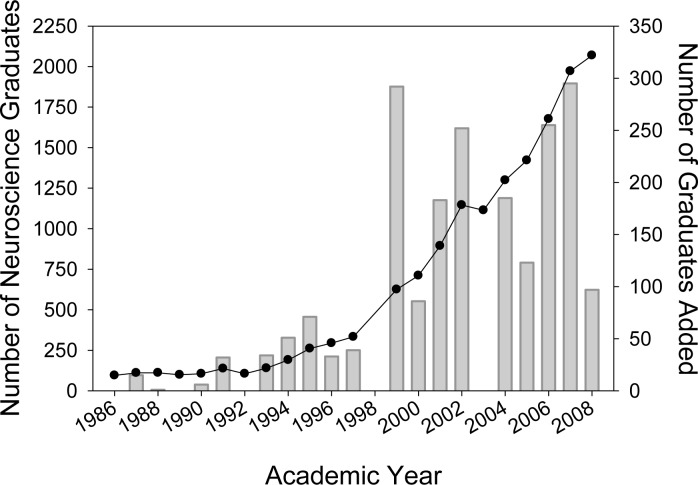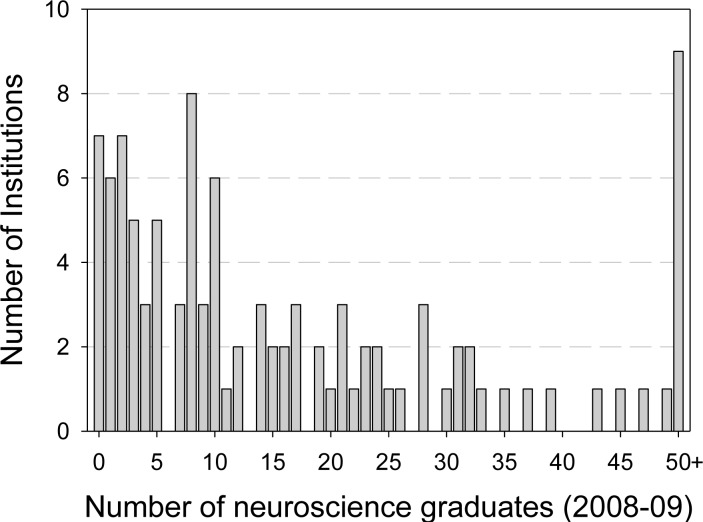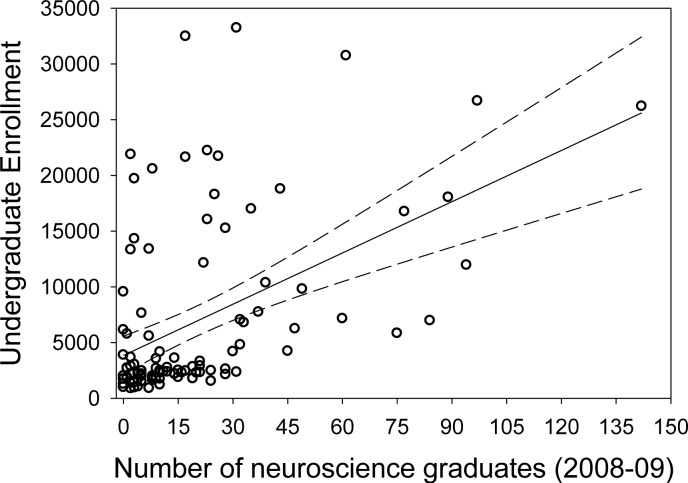Abstract
Despite an apparent increase in undergraduate neuroscience programs offered by colleges and universities, there has been little effort to document this growth. In the present report we describe our analysis of the expansion of undergraduate neuroscience programs of study over more than 20 years and detail a number of institutional characteristics of colleges and universities that offer undergraduate neuroscience programs. These data reveal more than 100 institutions with undergraduate neuroscience programs as well as over 2000 college graduates that majored in neuroscience in 2008–2009. Understanding the current number as well as growth trends of undergraduate neuroscience programs found in U.S. colleges and universities has implications for neuroscience educators as well as for the funding of neuroscience research and educational activities.
Keywords: neuroscience education, undergraduate neuroscience major
INTRODUCTION
Few academic programs have undergone more changes in undergraduate education than that seen for neuroscience. This includes an increase in neuroscience-related courses offered (both lecture and lab-based), the establishment of neuroscience majors and minors, opportunities for neuroscience research experiences, and the creation of entire neuroscience departments. Despite the fact that these academic and curricular changes take place in an increasing number of colleges and universities, and that there has been greater discussion of the place for neuroscience in undergraduate education (Lewis, 2006), few efforts have sought to document the expansion of neuroscience in undergraduate collegiate education (Hardwick and Smith, 2010).
In the present report we describe the current undergraduate neuroscience programs/majors found in the U.S. as of the 2008–2009 academic year and evaluate several characteristics of these institutions based on data from the U.S. Department of Education. In addition, we used archival data to document the growth of undergraduate neuroscience programs/majors in the U.S. over more than the past twenty years. These data are relevant toward development of methods to evaluate the growth of collegiate neuroscience education and can be of use to institutions interested in expanding their neuroscience curriculum.
MATERIALS AND METHODS
Our study was designed to only use publically-available information found on the internet to document various aspects of undergraduate neuroscience education in the U.S. We used this design because it would most-closely approximate the kind of searches that would be employed by graduating high-school students, college guidance councilors, scientists, educators, post-doctoral fellows, and those looking for open faculty positions.
As described below, we searched through the websites/databases of the Association of Neuroscience Departments and Programs (ANDP; andp.org), the National Center for Education Statistics (NCES; nces.gov.ed), and the Integrated Postsecondary Education Data System (IPEDS; nces.gov.ed/ipeds).
We used the College Navigator database of NCES (nces.gov.ed/collegenavigator) and performed searches based on the 1] Programs/Majors (e.g., neuroscience, psychobiology), 2] Level of Award (e.g., bachelor’s, doctoral), 3] Institution Type (e.g., public, private). Similar search strategies were used for current and archival data on the IPEDS database. Both of these databases contain data based on reported numbers of graduates (including n=0 graduates) for all programs/majors offered by an institution. Reporting of these data is mandated by the U.S. Department of Education and includes data up to and including the 2008–2009 academic year. We could not find data from the 1998–1999 academic year. Neuroscience is listed in both databases under “Multi/Interdisciplinary studies” (CIP Code 30.24).
All data was imported into Microsoft Excel and all annotation, sorting, data management, etc. were performed using Excel. All figures were prepared using SigmaPlot (v10).
RESULTS:
Characteristics of undergraduate neuroscience programs/majors
We found few individual internet resources with general information about undergraduate neuroscience educational programs of study in the U.S. Thus, despite the fact that internet searches for terms such as “undergraduate neuroscience major” results in ∼6 million websites, we did not find sites with comprehensive lists of neuroscience programs found throughout the U.S. Instead the vast majority of these websites were specific to programs offered by individual colleges and universities. Reviewing and annotating these materials to create our own comprehensive list was determined to be time prohibitive. However, we did identify that the Association of Neuroscience Departments and Programs (ANDP) maintains a website allowing for searches of neuroscience programs in North America, Canada, and abroad. Surprisingly, searches of the ANDP website revealed less than forty institutions currently offering undergraduate neuroscience-related programs of study in the U.S. which may be due to the fact that there is a membership fee to be listed.
Recognizing that the ANDP list was incomplete, we searched for additional resources for determining the number of U.S. institutions that offer undergraduate neuroscience programs of study. Continued searches of the web via a number of search strategies led us to the website of the National Center for Education Statistics (NCES), a branch of the Institute of Education Sciences of the U.S. Department of Education. This website includes the College Navigator search engine containing data from all U.S. colleges and universities. Searches can be performed according to the 1] name of the institution, 2] institution location (state, zip code), 3] program/major name, 4] level of award/degree (associate’s, bachelor’s, etc.), 5] institution type (private, public). We also used the Integrated Postsecondary Education Data System (IPEDS) database to search through current and archival data.
We used the “program/major” search feature of the College Navigator database to examine the distribution of institutions with undergraduate programs called “neuroscience” which resulted in an output of 104 institutions. Recognizing that institutions might have neuroscience programs that have a different program name we expanded our search to include all undergraduate programs that contained the letter-string “neuro” which included: neurobiology/neurophysiology, electroneurodiagnostic tech, neuropharmacology, and neuroanatomy. These searches revealed an additional eight institutions that have programs of study called “neurobiology/neurophysiology.” There were no institutions with any of the other undergraduate “neuro”-based programs. (Note that Muskingum University has programs listed for “neuroscience” and “neurobiology”). These data are found in Supplementary Table 1 and reveal one of the most comprehensive lists of undergraduate neuroscience programs of study in the U.S. than has been previously published.
We further expanded our search of the NCES database in order to identify programs of study that are related to neuroscience that might have different program names. A search for programs containing the term “brain” resulted in zero programs. Searches for programs with the term “cognitive” resulted in 32 undergraduate “cognitive science” programs. Searches for programs with the term “biopsychology” or “psychobiology” revealed 24 and 32 programs, respectively. These data and those described above are found in Figure 1 and Supplementary Table 1 and indicate that there are numerous neuroscience-related programs found at U.S. colleges and universities. Further analyses revealed 22 institutions that had two neuroscience-related related programs (e.g., neuroscience & cognitive science), one institution that three neuroscience-related programs (University of California – Los Angeles), and one institution that had four neuroscience-related programs (Carnegie Melon University).
Figure 1.
Analysis of undergraduate neuroscience and neuroscience-related programs as of the 2008–2009 academic year.
Using information obtained from the NCES database, we determined a number of interesting characteristics of institutions which offer undergraduate neuroscience programs of study. For example, among the 111 institutions in our combined “neuro” (neuroscience and neurobiology/neurophysiology) NCES dataset, only 20 (18%) schools were public while the remaining 91 (82%) schools were private, non-profit institutions. In addition, nearly a quarter of all schools in our database were bachelor’s degree-granting only institutions (23.4%; 26 schools). Only 46 (41.4%) schools in our list were bachelor’s/master’s degree-granting schools and 39 schools (35.1%) were bachelor’s/master’s/post-master’s degree-granting institutions. Not surprisingly, the average number of undergraduates in all majors found at institutions on our list was relatively small (7372.33) with a large standard deviation (8353.35). Nearly 60% (66/111; 59.46%) of all institutions on our list had less than 4000 undergraduates and we found that bachelor’s degree-granting only schools had even smaller student bodies averaging less than 2000 students (mean=1862.96 students; stdev=447.46; n=26 schools). The other institution-types had significantly larger undergraduate student body populations than the bachelor’s-only institutions (Independent samples t-test; bachelor’s only vs. bachelor’s/master’s: p<0.01; bachelor’s only vs. post-master’s: p<0.001). These data reveal that the majority of institutions with undergraduate neuroscience programs are bachelor’s-only and bachelor/master’s degree-granting, private colleges that can often have relatively small undergraduate student bodies.
We further analyzed our data and performed new searches in order to determine the number of institutions that have both undergraduate as well as graduate programs in neuroscience and/or neurobiology/neurophysiology. These searches revealed that seven schools have bachelor’s, master’s, and doctoral-level neuroscience programs; 14 schools have bachelor’s and doctoral programs, 10 schools have bachelor’s and master’s programs. Conversely, we found that there are 25 institutions that report having only a doctoral-level neuroscience program and 29 that report having only a master’s level program. One important caveat to these data is that medical schools are not found in this list. These and associated data are shown in Figure 2 and are found in Supplementary Table 2.
Figure 2.
Analysis of the types of neuroscience programs of study found in U.S. colleges according to the type of degree awarded as of the 2008–2009 academic year.
Eligibility of institutions with undergraduate neuroscience programs for NIH R15/AREA grants
Our results indicate that the majority of colleges with undergraduate neuroscience programs of study are private, primarily-bachelor’s/master’s degree-granting institutions with fewer than 4000 students. Since these types of institutions often have small research infrastructures, we determined the percentage of schools in our dataset that are eligible for R15/Academic Research Enhancement Award Grants (AREA) from the National Institutes of Health (NIH). The list of all eligible schools in the U.S. can be found at the following NIH website: (http://grants.nih.gov/grants/funding/area_ineligible.xls).
This metric serves as an upper-limit estimate of the dollar amount of NIH funding that a college receives as only institutions with <$6 million of funding are eligible for R15 grants. Thus, we found that two-thirds (74/111; 66.67%) of schools on our NCES list are R15-eligible institutions. Not surprisingly, 25 of R15-eligible schools were bachelor’s only degree-granting schools and only 15 of R15-eligible schools had some kind of post-master’s program. These data are presented in Supplementary Table 1 and indicate that the majority of colleges with undergraduate neuroscience programs of study receive modest NIH funding which may reflect a limited research infrastructure at these institutions and/or a primary emphasis on teaching.
Analysis of the growth of undergraduate neuroscience programs
Data found in the IPEDS data center allow for analysis of the growth of undergraduate neuroscience programs since 1986. Using these data we calculated the number of institutions reporting to have an undergraduate program in “neuroscience”. As shown in Figure 3, while only seven institutions reported having an undergraduate program in 1986, that number more than tripled ten years later (25 schools in 1996) and more than tripled again by 2006 (90 schools in 2006). Since 2006, there has been a smaller but steady increase in the number of institutions adding undergraduate neuroscience programs of study.
Figure 3.
Growth of undergraduate neuroscience programs. Number of institutions that report having an undergraduate neuroscience program (black line and filled circles; left-side y-axis) and the number of institutions with neuroscience programs added compared to previous year (gray bars; right-side y-axis).
Analysis of graduates from undergraduate neuroscience programs
Data found in the IPEDS data center allow for analysis of the number of graduates of neuroscience programs since 1986. As shown in Figure 4 and Supplementary Table 3, in 1986 there were 95 graduates, compared to 294 in 1996 and 1677 graduates in 2006. In 2008, there were more than 2000 graduates from undergraduate neuroscience programs. These data point to growth in the number of students pursuing and completing neuroscience majors across all institutions. However, data in Supplementary Table 3 also allow for examination of the number of neuroscience graduates at individual institutions and provide some clue as to the popularity of the program. For example, University of Michigan-Ann Arbor reported 142 graduates in 2008–2009 which was the highest number reported by any institution. Fewer than 20 graduates were reported by 68 schools and only nine schools reported more than 50 graduates. These data are illustrated in Figure 5. In order to examine whether a relationship exists between the size of the undergraduate student body and the number of neuroscience graduates at a given institution, we graphed these two variables on a scatterplot (data from 2008–09 academic year). As shown in Figure 6, the number of neuroscience graduates reported by institutions varied greatly according to undergraduate enrollment. For example, institutions with over 20,000 undergraduates could have fewer than 10 or more than 100 neuroscience graduates. However, we found a significantly positive linear correlation (R=0.48; p<0.001) between undergraduate enrollment and number of neuroscience graduates.
Figure 4.
Increase in the total number of reported graduates from undergraduate neuroscience programs/majors. Number of graduates of undergraduate neuroscience programs (black line and filled circles; left-side y-axis) and the number of additional graduates of neuroscience programs added compared to previous year (gray bars; right-side y-axis)
Figure 5.
Histogram of the number of institutions and number of reported graduates from neuroscience programs in 2008–2009.
Figure 6.
Correlation between undergraduate enrollment and number of graduates from undergraduate neuroscience programs. Linear regression and 95% confidence intervals indicated by solid line and dashed lines, respectively.
DISCUSSION
The present report details our work to create a comprehensive database of U.S. colleges and universities that offer undergraduate neuroscience programs/majors. Surprisingly, we did not find any helpful internet resources other than the NCES/College Navigator and IPEDS databases. In light of the fact that most people do not know about the NCES and IPEDS resources, these data suggest that most individuals (high-school seniors, college guidance councilors, neuroscience educators, etc.) looking for internet resources about undergraduate neuroscience education will likely be overwhelmed with all of the individual websites from particular institutions when performing general internet searches. Thus, data from the present report provide important information for a diverse audience of students, educators, scientists, administrators, and policy makers.
Using available data, we examined a number of institutional characteristics of colleges with undergraduate neuroscience programs of study in order to determine possible features that are common to these institutions. These analyses revealed that most colleges with undergraduate neuroscience programs are private, non-doctoral degree-granting institutions with fewer than 4000 students. Thus, despite the fact that large universities often have more diverse programs of study compared to smaller institutions, undergraduate neuroscience education has become part of the curricular/program offerings of many small colleges. Surprisingly, we found over 50 institutions that had graduate but not undergraduate neuroscience programs. Understanding why larger colleges and universities have been slower in expanding their undergraduate neuroscience programs is an important area for future study.
We found that most colleges with undergraduate neuroscience programs qualify for the NIH R15 funding mechanism. These data suggest that these institutions receive less than $6 million in NIH funding and may be an indicator of the research infrastructure found at many of these schools. These data may reflect limited neuroscience research activities that take place at these institutions and may provide clues as to the number of research opportunities that are available to neuroscience undergraduate majors that these schools. Surprisingly, results from a recent survey study indicated that ∼20% faculty at primarily undergraduate institutions with some form of neuroscience program were NIH-funded and mentor more than one undergraduate research assistant (Hardwick and Smith, 2010). An important area for further investigation relates to what extent small institutions with undergraduate neuroscience programs are able to provide research experiences to undergraduate majors.
Data used in the present report comes from NCES and IPEDS databases which we found to be more detailed than any other internet resource that we examined including the ANDP database. The information found in these databases is self-reported by institutions under a U.S. Department of Education mandate. Nevertheless, the accuracy and completeness of these data is unknown and merits further investigation. Some preliminary secondary analyses indicate some level of incompleteness, though the NCES and IPEDS databases are soon to be updated with data from the 2009–2010 academic year. For example Queens College (one of our own institutions) has an undergraduate major in neuroscience since 2005, that is not listed in the NCES database perhaps because the program is administered by both psychology and biology departments as is the case for numerous other institutions (Hardwick and Smith, 2010). Despite these limitations, it is likely that our use of NCES and IPEDS data includes more data, especially archival data, than would have been obtained by other methods such as a survey, which is biased by the method of distribution of the survey as well as the number of respondents.
Much of our analyses focused on institutions that reported having undergraduate “neuroscience” programs in particular. Thus, an important limitation to the present study is that identical programs of study that are called by a different name are likely not included in our search results such as neuroscience programs, minors, and/or concentrations that are “nested” within psychology or biology departments (Wiertelak and Ramirez, 2008). Nevertheless, we chose to narrowly search for programs called “neuroscience” and “neurobiology/neurophysiology” because the establishment of these kinds of undergraduate programs reflects a specific effort on the part of faculty and administrators to promote, advocate, and advertise undergraduate neuroscience education at their institution (Lewis, 2006) compared to a minor or concentration in neuroscience. These data also suggest that institutional administrators who are responsible for reporting programs/majors and the number of graduates to the U.S. Department of Education make sure to have their program listed under “neuroscience” (CIP Code 30.24) rather than under a different classification category.
CONCLUSIONS
“How many undergraduate neuroscience programs exist in the U.S.?” Finding an answer to this question remains an important and ongoing challenge. In the present report we have created one of the most comprehensive lists of institutions with undergraduate neuroscience programs. We hope that the undergraduate neuroscience community will help to update and expand this list as undergraduate neuroscience programs continue to grow in our nation’s colleges and universities.
Supplementary Materials
REFERENCES
- Hardwick JC, Smith JS. Undergraduate neuroscience faculty: results from a Survey of Faculty for Undergraduate Neuroscience Members. J Undergrad Neurosci Edu. 2010;8:A101–A107. [PMC free article] [PubMed] [Google Scholar]
- Lewis RS. Neuro Now!: Should neuroscience be a department or program. J Undergrad Neurosci Edu. 2006;4:E11–E13. [PMC free article] [PubMed] [Google Scholar]
- Wiertelak EP, Ramirez JJ. Undergraduate neuroscience education: blueprints for the 21st century. J Undergrad Neurosci Edu. 2008;6:A34–A39. [PMC free article] [PubMed] [Google Scholar]
Associated Data
This section collects any data citations, data availability statements, or supplementary materials included in this article.



